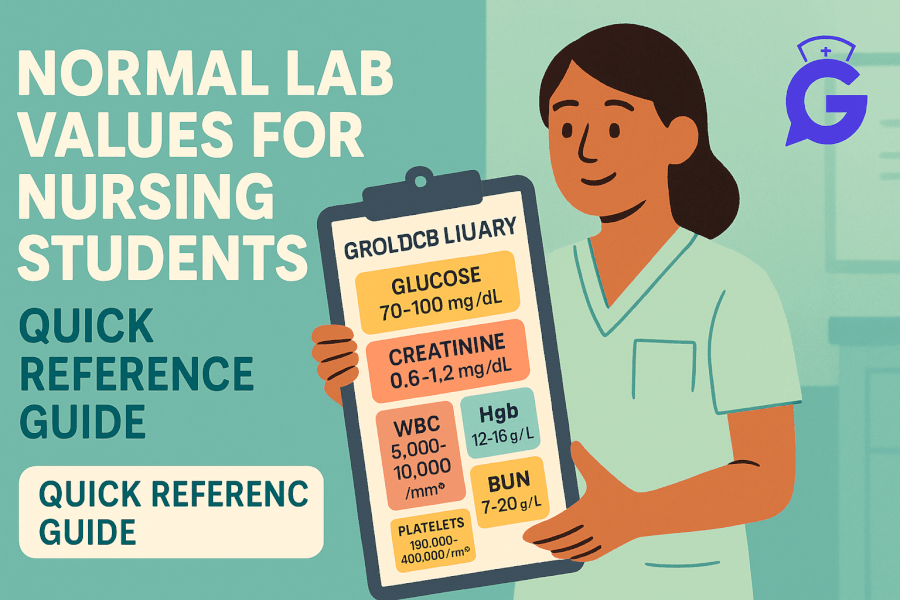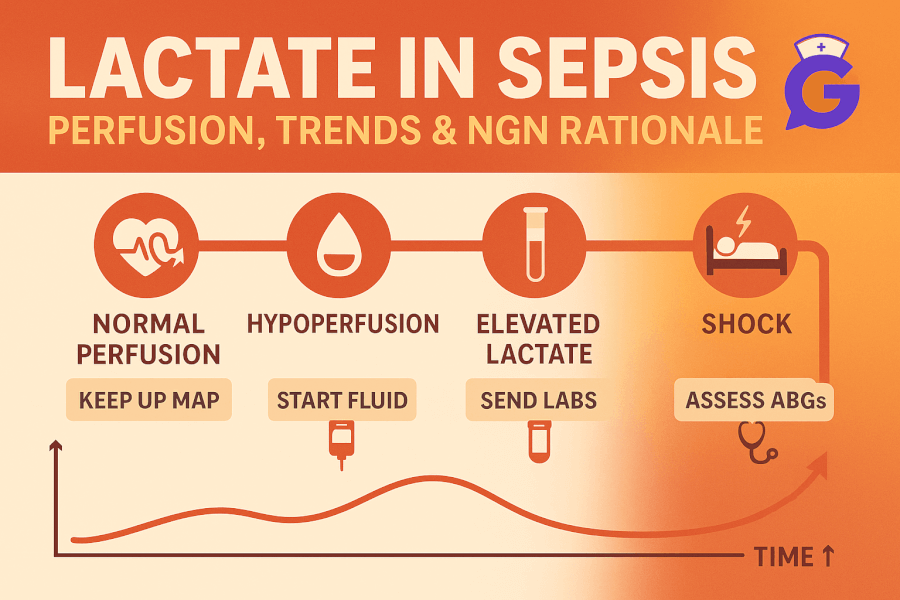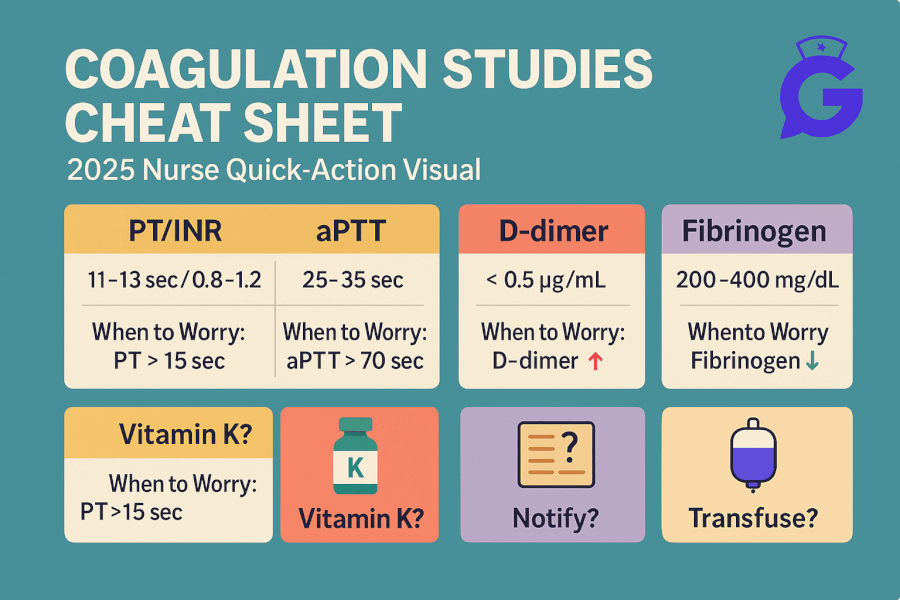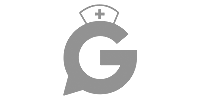Lab values show whether your actions are working. This guide gives you a nursing-focused overview of common reference ranges, fast interpretation patterns, and where these numbers show up on NGN. Use it as a cheat sheet during school and a grounding map when cases get noisy.
Important: Ranges vary by lab, assay, and population. Always compare against your hospital’s or course’s reference ranges.
Table of Contents
- How to Use This Cheat Sheet
- CBC (Complete Blood Count)
- Basic Metabolic Panel / Electrolytes
- Comprehensive Metabolic Panel (LFTs, Proteins)
- Renal Markers and Urine Basics
- Cardiac Markers and Lactate
- Coagulation Studies
- ABG: Arterial Blood Gas Reference
- Fast Patterns and Mnemonics
- NGN Tie-Ins: Action → Parameter Pairs
- FAQs
- Further Reading
🎯 Free NCLEX quiz!
Test your knowledge—new quizzes added weekly!
How to Use This Cheat Sheet
- Skim the tables before clinical or exams to refresh anchors.
- When a lab is off, name the likely problem pattern and pick the two fastest ways to improve physiology.
- For NGN, pair every action with a parameter you’ll recheck soon (10–30 minutes when appropriate).
If case stems feel dense, warm up with How to Read NGN Case Stems (2025) and then drill category practice in NGN Case Studies (2025).
CBC (Complete Blood Count)
| Test | Typical Adult Range* | What to Watch |
|---|---|---|
| WBC | 4.0–11.0 ×103/µL | ↑ infection/inflammation; ↓ immunosuppression or marrow issue |
| Hemoglobin (Hgb) | F: 12–16 g/dL; M: 13.5–17.5 g/dL | ↓ anemia/bleeding; ↑ dehydration |
| Hematocrit (Hct) | F: 36–46%; M: 41–53% | Tracks with Hgb; hemodilution vs concentration |
| Platelets | 150–400 ×103/µL | ↓ bleeding risk (HIT); ↑ inflammation/clot risk contexts |
| RBC | F: 3.8–5.2; M: 4.3–5.7 ×106/µL | Trend with indices for anemia types |
| MCV | 80–100 fL | Microcytic vs macrocytic anemia clues |
*Ranges vary by lab; use your facility’s references.
Basic Metabolic Panel / Electrolytes
| Test | Typical Adult Range* | Notes |
|---|---|---|
| Sodium (Na⁺) | 135–145 mEq/L | Fluid/neurologic status; rapid shifts are risky |
| Potassium (K⁺) | 3.5–5.0 mEq/L | Cardiac conduction; watch with diuretics/insulin |
| Chloride (Cl⁻) | 96–106 mEq/L | Acid–base partner with bicarbonate |
| CO₂ (HCO₃⁻) | 22–29 mEq/L | Metabolic component of acid–base balance |
| BUN | 7–20 mg/dL | Hydration and renal perfusion trends |
| Creatinine | ~0.6–1.3 mg/dL | Renal filtration; compare to baseline |
| Glucose (fasting) | 70–99 mg/dL | Context: DM therapy, sepsis, steroids |
| Calcium (total) | 8.6–10.2 mg/dL | Correct for albumin; neuromuscular excitability |
| Magnesium | 1.7–2.2 mg/dL | Arrhythmias, preeclampsia therapy, torsades |
| Phosphorus | 2.5–4.5 mg/dL | Refeeding, bone/renal issues |
Comprehensive Metabolic Panel (LFTs, Proteins)
| Test | Typical Adult Range* | Notes |
|---|---|---|
| AST | ~10–40 U/L | Hepatocellular injury (with ALT) |
| ALT | ~7–56 U/L | More liver-specific than AST |
| Alkaline Phosphatase (ALP) | ~40–129 U/L | Cholestasis, bone turnover |
| Total Bilirubin | ~0.2–1.2 mg/dL | Hemolysis vs cholestasis patterns |
| Albumin | 3.5–5.0 g/dL | Nutrition, oncotic pressure, corrected Ca²⁺ |
| Total Protein | 6.0–8.3 g/dL | Globulins, hydration |
Renal Markers and Urine Basics
| Measure | Typical Range / Goal | Notes |
|---|---|---|
| eGFR | >60 mL/min/1.73m² | Trend over time; dose meds renally |
| Urine Output | ≥0.5 mL/kg/hr | Perfusion check; Foley only if indicated |
| Urinalysis Highlights | Negative nitrites/LE/protein/glucose | Infection, kidney disease, DM clues |
Cardiac Markers and Lactate
| Marker | Reference Point | Notes |
|---|---|---|
| Troponin (contemporary/high-sensitivity) | Assay-specific; abnormal at the 99th percentile | Use serial trends and clinical picture |
| BNP / NT-proBNP | Often <100 pg/mL (BNP) in non-HF | Interpret with age, renal function, obesity |
| Lactate | ~0.5–2.2 mmol/L | Perfusion/oxygen debt; sepsis resuscitation target is trend down |
| CK-MB (legacy) | Declining use | Troponin preferred |
Coagulation Studies
| Test | Typical Range* | Notes |
|---|---|---|
| PT | ~11–13.5 s | Warfarin monitoring with INR |
| INR | ~0.8–1.2 (non-anticoagulated) | Therapeutic often 2.0–3.0 depending on indication |
| aPTT | ~25–35 s | Heparin effect; therapeutic range per protocol |
| Fibrinogen | ~200–400 mg/dL | Low in DIC, massive hemorrhage |
| D-dimer | Assay-specific; often <0.5 mg/L FEU | Rule-out tool; many false positives |
ABG: Arterial Blood Gas Reference
| Component | Typical Range* | Interpretation Hints |
|---|---|---|
| pH | 7.35–7.45 | <7.35 acidosis; >7.45 alkalosis |
| PaCO₂ | 35–45 mmHg | Respiratory component (inverse with pH) |
| HCO₃⁻ | 22–26 mEq/L | Metabolic component (direct with pH) |
| PaO₂ | 80–100 mmHg (room air, adult) | Age/altitude dependent; interpret with pulse ox |
| SaO₂ | 95–100% | Check perfusion/hemoglobin factors |
| Anion Gap | ~8–12 mEq/L (lab dependent) | High gap metabolic acidosis patterns (MUDPILES) |
Fast Patterns and Mnemonics
- Hyponatremia with neuro changes → think fluid shifts; correct slowly.
- Potassium out of range with ECG changes → stabilize myocardium and correct carefully.
- Rising creatinine after contrast → remove nephrotoxins, hydrate per protocol, trend output.
- AST/ALT both up → hepatocellular process; ALP + bilirubin up → cholestasis pattern.
- Lactate trending up in infection → suspect worsening perfusion; fluids/pressors per protocol and re-check.
- ABG quick start:
- pH tells acidosis vs alkalosis.
- PaCO₂ and HCO₃⁻ tell respiratory vs metabolic.
- Decide compensation and whether oxygenation is adequate.
If ABGs feel slippery, schedule [ABG Interpretation Made Simple (coming in this series)] and, for practice now, work related cases in Med-Surg Physiological Adaptation.
NGN Tie-Ins: Action → Parameter Pairs
To score consistently on NGN, pick actions that change physiology and parameters that prove it worked soon.
- Hypoxia pattern → actions: oxygen, position; parameters: SpO₂, respiratory rate/work of breathing.
- Hypovolemia/bleed → actions: large-bore IVs, fluids; parameters: MAP/BP, urine output.
- DKA → actions: fluids then insulin; parameters: potassium, anion gap, glucose trend.
- Hepatic cholestasis → actions: trend LFTs, evaluate obstruction, manage symptoms; parameters: bilirubin, ALP, pruritus relief.
- Anticoagulation change → actions: manage dose/antidote per protocol; parameters: INR/aPTT, bleeding signs.
For full NGN walk-throughs, see 25 Free Case Studies and category sets in Pediatrics & Psych and Maternal–Newborn.
FAQs
Are these ranges the same everywhere?
No. Use your facility’s or course’s ranges. This sheet is for orientation and exam practice.
How should I memorize lab values?
Group by pattern: electrolytes together, renal pair (BUN/Cr), LFT set (AST/ALT/ALP/bili), coags, and ABG trio. Turn tables into flashcards and review them in short daily sets. If you use AI, convert this page into a two-page study guide with quiz questions using the AI Prompt Library.
What’s the difference for pediatrics or pregnancy?
Ranges and normal physiology shift. For example, newborn bilirubin runs higher early on; pregnancy alters proteins and volume. Always use population-specific references.
How do I connect labs to actions on NGN?
Name the single priority first, then pick two actions that change physiology and two parameters that will show improvement soon. Practice with Bow-Tie Items and Matrix/Grid Items.
Do I need to memorize troponin cutoffs?
Know that positivity is defined by your lab’s assay-specific 99th percentile and that trends plus symptoms/ECG drive decisions.







